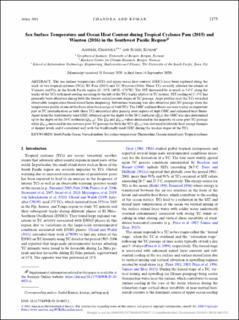Sea Surface Temperature and Ocean Heat Content during Tropical Cyclones Pam (2015) and Winston (2016) in the Southwest Pacific Region
Journal article, Peer reviewed
Published version

View/
Date
2021Metadata
Show full item recordCollections
- Geophysical Institute [1185]
- Registrations from Cristin [9462]
Original version
Monthly Weather Review. 2021, 149(4), 1173–1187 https://doi.org/10.1175/MWR-D-20-0025.1Abstract
The sea surface temperature (SST) and upper ocean heat content (OHC) have been explored along the track of two tropical cyclones (TCs), TC Pam (2015) and TC Winston (2016). These TCs severely affected the islands of Vanuatu and Fiji, in the South Pacific Region (8°–30°S, 140°E– 170°W). The SST decreased by as much as 5.4°C along the tracks of the TCs with most cooling occurring to the left of the TCs tracks relative to TCs motion. SST cooling of 1-5°C has generally been observed during both the forced and relaxation stages of TC passage. The Argo profiles near the TC revealed observable mixed layer deepening. Subsurface warming was also observed post-TC passage from the temperature profile of one of the floats after the passage of both TCs. The OHC and heat fluxes are seen to play an important part in TC intensification as both these TCs intensified after passing over the regions of high OHC and enhanced heat fluxes. Apart from the traditionally used OHC obtained up to the depth of the 26°C isotherm (QH), the OHC was also determined up to the depth of the 20°C isotherm (QH,20). The QH and QH,20 values decreased in the majority of cases post TC passage while QH,20 increased in one instance post-TC passage for both the TCs. QH,20 has also been used to identify heat energy changes at deeper levels and correlated well with the traditionally used OHC during the weaker stages of the TCs.